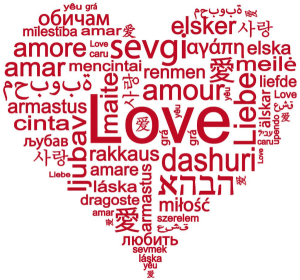In our interconnected world, the idea of ‘love’ crosses borders and languages, taking on many forms that show the complexity of human culture. Our guide to the word ‘love’ in 80 languages not only expands our vocabulary but also gives us a way to see how different cultures view and express this universal feeling.
Each translation reveals how people around the world celebrate love, which can change how we understand relationships and communicate across cultures. What can we learn about each other by exploring the many ways we express love?

List of 80 ways to say “love” in different languages
| Language | Love | I love you |
|---|---|---|
| Afrikaans | Liefde | Ek het jou lief |
| Albanian | Dashuri | Unë të dua |
| Amharic | ፍቅር (Fik’iri) | እወድሻለሁ (iwedishalehu) |
| Arabic | (Alhubu) الحب | أحبك (uhibek) |
| Armenian | Սեր (ser) | Ես քեզ սիրում եմ (Yes k’ez sirum yem) |
| Aymara | Munaña | Munsmawa |
| Azerbaijani | Sevgi | Mən səni sevirəm |
| Basque | Maitasuna | Maite zaitut |
| Belarusian | Каханне (kahannie) | я цябе кахаю (ja ciabie kahaju) |
| Bengali | ভালবাসা (Bhālabāsā) | আমিতোমায়ভালোবাসি (Ami tomake bhalobashi) |
| Bosnian | Ljubav | Volim te |
| Bulgarian | Любов (Lyubov) | Обичам те (Obicham te) |
| Burmese | အချစ် (Aahkyit) | မင်းကိုချစ်တယ် (Mainnkohkyittaal) |
| Cantonese | 愛 (ngoi) | 我愛你 (Ngo oiy ney a) |
| Catalan | Amor | T’estimo |
| Cebuano | Gugma | Gihigugma tika |
| Chichewa | Chikondi | Ndimakukondani |
| Corsican | Amore | Ti tengu caru |
| Croatian | Ljubav | Volim te |
| Czech | Láska | Miluji tě |
| Danish | Kærligheden | Jeg elsker dig |
| Dutch | Liefde | Ik houd van je |
| English | Love | I love you |
| Estonian | Armastus | Ma armastan sind |
| Ewe | lɔ̃ | Melɔ̃ wò |
| Farsi (Persian) | (eshgh) عشق | ( dooset daram) دوستت دارم |
| Fijian | Loloma | Au domoni iko |
| Filipino | Pag-ibig | Mahal kita |
| Finnish | Rakkaus | Minä rakastan sinua |
| French | Amour | Je t’aime |
| Gaelic (Irish) | Grá | Is breá liom tú |
| Galician | Amor | Quérote |
| Georgian | Სიყვარული (siq’varuli) | Მიყვარხარ (Miq’varkhar) |
| German | Liebe | Ich liebe dich |
| Greek | Αγάπη (agápi) | Σε αγαπώ (Se agapó) |
| Guarani | Mborayhu | Rohayhu |
| Haitian Creole | Lanmou | Mwen renmen ou |
| Hawaiian | Aloha | Aloha wau iā ʻoe |
| Hebrew | אהבה (ahava) | אני אוהב אותך (ani ohev otkha) |
| Hindi | प्यार (pyaar) | मैं आपसे प्यार करती हूँ (main aapase pyaar karatee hoon) |
| Hmong | Kev hlub | Kuv hlub koj |
| Hungarian | Szeretet | Szeretlek |
| Icelandic | Ást | Ég elska þig |
| Igbo | Ihunanya | A hụrụ m gị n’anya |
| Ilocano | Ayat | Ay-ayaten ka |
| Indonesian | Cinta | Aku mencintaimu |
| Italian | Amore | Ti amo |
| Japanese | 愛 (ai) | 愛してます (Aishitemasu) |
| Kazakh | Махаббат (maxabbat) | Мен сені жақсы көремін (Men seni jaqsı köremin) |
| Khmer | សេចក្ដីរសលាញ់ (sechakdei rsa lea nh) | ខ្ញុំស្រលាញ់អ្នក (khnhom sralanh anak) |
| Kinyarwanda | Urukundo | Ndagukunda |
| Korean | 사랑 (salang) | 사랑해요 (salanghaeyo) |
| Kurdish | Evîn | Ez hej te dikim |
| Lao | ກາມາຣົມ (kamarom) | ຂ້ອຍຮັກເຈົ້າ (khony hak chao) |
| Latin | Amor | Te amo |
| Latvian | Mīlestība | Es mīlu Tevi |
| Lithuanian | Meilė | Aš tave myliu |
| Luxembourgish | Léift | Ech hunn dech gär |
| Malagasy | Fitiavana | Tiako ianao |
| Malay | Cinta | Saya sayang awak |
| Maltese | Imħabba | Inħobbok |
| Mandarin | 爱情 (Àiqíng) | 我愛你 (Wǒ ài nǐ) |
| Maori | Aroha | Aroha ana ahau ki a koe |
| Mongolian | Хайртай (khairtai) | Би чамд хайртай (Bi chamd khairtai) |
| Nahuatl | Tlazohtiliztli | Nimitztlazohtla Nimitznequi |
| Navajo | Ánííníshní’ | Ayóó’ánííníshní |
| Nepali | माया (māyā) | म तिमीलाई माया गर्छु (Ma timīlā’ī māyā garchu) |
| Norwegian | Kjærlighet | Jeg elsker deg |
| Pashto | (meena) مينه | (zaa sta are meena laram) زه ستا سره مینه لرم |
| Polish | Miłość | Kocham cię |
| Portuguese | Amor | Te amo |
| Punjabi | ਪਿਆਰ (pi’āra) | ਮੈਂ ਤੁਹਾਨੂੰ ਪਿਆਰ ਕਰਦਾ ਹਾਂ (Maiṁ tuhānū pi’āra karadā hāṁ) |
| Oromo | Jaalala | Sin jaalladha |
| Quechua | Kuyay | Kuyaykim |
| Romanian | Dragoste | Te iubesc |
| Russian | Любовь (lyubov’) | Я тебя люблю (Ya tebya lyublyu) |
Exploring how different languages express ‘love’ helps us appreciate global cultures and communication better. Each language shapes this deep emotion uniquely. For example, ‘Amor’ in Spanish and Portuguese carries a Latin warmth.
‘Liebe’ in German sounds solid. In the East, ‘Ai’ in Mandarin and ‘Sarang’ in Korean add symbolic depth. In the Middle East, ‘Hubb’ in Arabic shows passionate depth.
The variety continues with ‘Lyubov’ in Russian and ‘Pyaar’ in Hindi, each bringing cultural flavor. This linguistic diversity teaches us that love is universal yet culturally unique.

Final Words
Love is a universal language that goes beyond borders and language barriers, connecting people everywhere. As we’ve seen the different ways to say ‘love’ around the world, it’s clear that while the words may change, the core feeling does not.
Here are the main points:
- Everyone understands love, though we all show it differently.
- Language makes our experience and expression of love richer.
- Learning how others express love fosters respect.
- Valuing language differences can strengthen bonds.
Exploring languages shows us not just how to say ‘love,’ but also how deeply we can connect by understanding its different expressions. Love, in any language, is a strong sign of our emotions and cultural depth.

